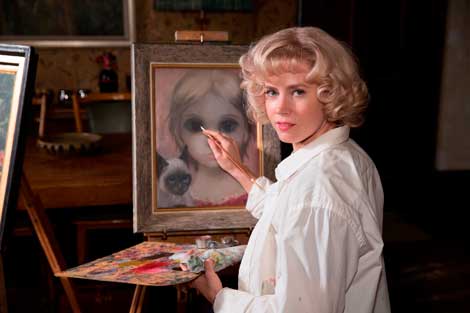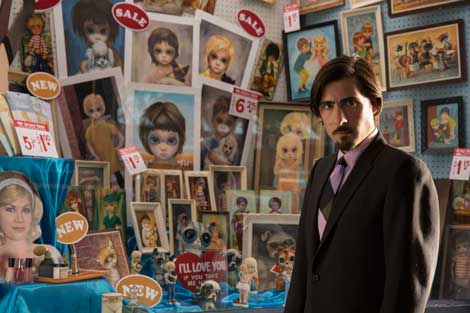It’s an amazing true story—the real story behind the phenomenally successful paintings of those children with those big, sad eyes of the ’50s and ’60s, the ones that defined “kitsch.” We always thought it was this fellow named Walter Keane who painted them, but it turns out Keane was just a hack who claimed his wife’s work as his own. In the new film Big Eyes, Tim Burton takes on a biopic of the real artist, Margaret Keane, and assumes her point of view. Or does he?
As played by Christoph Waltz, Walter is a charming scoundrel who wants to be an artist so badly that he puts his name on other people’s work. Margaret (Amy Adams) is a 1950s divorcee and mother who is trying to make ends meet as a sidewalk artist. At first Walter makes an effort to boost her timid ego, and they get married in a whirlwind courtship, replete with a honeymoon in Hawaii. A decade later, he’s trying to tear her down, coercing her to keep working away, while keeping her authorship a secret—even from her own daughter. After all, as Walter says, people don’t buy “lady art.” Later he argues that the deception had gone on too long to be corrected—without dire consequences. Meanwhile, he profits handsomely, selling the “original” work, opening a gallery, and licensing the big-eyed images to be used in posters and products. It’s a nasty tale which Burton tries to keep lite. So lite the film seems weightless.
While the film has the director’s quirky touches, it doesn’t seem very inventive in that Burtonesque way we’ve come to expect. In certain scenes that scream for pushing into the realm of magic realism, the film remains too tame. A key problem is that the writing pair of Scott Alexander and Larry Karaszewski—with whom Burton teamed so successfully on Ed Wood—haven’t come up with a convincing script. Even the acting seems misguided. Waltz’ manic impersonation is over-the-top in a grating way (big smiles, big gestures, big talk), and Adams looks constipated playing the repressed, oppressed wife. For one thing, she fails to show or articulate much joy at being an artist—isn’t that part of what makes artists persevere despite poverty and lack of recognition? Margaret is often shown at her easel like a factory bee showing up for furniture decoration (which her character does do at one point). Speaking of furniture, the delightful production design by Rick Heinrichs is a highlight of the film, as is the period costuming by Colleen Atwood. But they can’t save it. Big Eyes is a missed opportunity to tell an amazing story in an amazing fashion.
Big Eyes, Directed by Tim Burton, written by Scott Alexander, Larry Karaszewski
In theaters Dec. 25, 2014 | Wide Release; 1 hr. 46 min.



